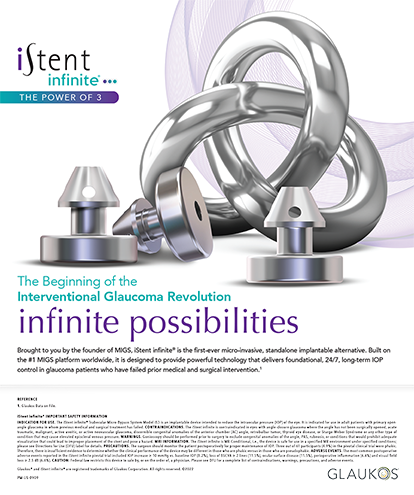


Comparison of Visual Quality and Subjective Outcomes Among 3 Trifocal Intraocular Lenses and 1 Bifocal Intraocular Lens
Martínez de Carneros-Llorente A, Martínez de Carneros A, Martínez de Carneros-Llorente P, Jiménez-Alfaro I1
ABSTRACT SUMMARY
Martínez de Carneros-Llorente and colleagues investigated whether trifocal IOLs delivered an enhanced third focus at intermediate visual acuity without a consequent loss of near or distance visual quality or a reduction in contrast sensitivity. One hundred sixty patients were randomly assigned to receive one of four lenses bilaterally. The options included three trifocal IOLs—an AcrySof IQ PanOptix lens (Alcon), which has recently become available in the United States, an AT LISA tri 839 MP lens (Carl Zeiss Meditec), and a FineVision lens (PhysIOL), both of which are not available in the United States—and one bifocal IOL, a Tecnis Multifocal 1-Piece lens (ZLB00, Johnson & Johnson Vision).
STUDY IN BRIEF
• A randomized trial compared the performance of one bifocal and three trifocal IOLs.
WHY IT MATTERS
This study addresses a concern that the addition of a third focal point will decrease contrast sensitivity in patients who receive trifocal IOLs. The trifocal lenses tested were equal to or better than the bifocal lens in all metrics, including low-contrast objective measurements at all distances measured and subjective assessments of patients’ real-world visual function.
Six months after surgery, there were no statistically significant differences between the four cohorts in terms of uncorrected distance visual acuity, corrected distance visual acuity, distance-corrected near visual acuity, reading speed, contrast sensitivity function under photopic or mesopic conditions, or subjective outcomes including driving as assessed by National Eye Institute Visual Function Questionnaire-25 (NEI VFQ-25).
The investigators paid particular attention to defocus curves at three levels of contrast. Under 100% contrast, visual acuity with all three trifocal IOLs was significantly better at -1.00 D defocus than with the bifocal lens. The PanOptix lens performed comparatively better at -1.50 to -2.00 D defocus, whereas the AT LISA tri IOL performed better at -0.50 D through all levels of positive defocus.
Under 50% contrast, all three trifocals performed significantly better than the bifocal IOL at -1.00 D. The AT LISA performed better at -0.50 D and at some levels of positive defocus, whereas the PanOptix lens offered superior visual acuity from -1.50 to -2.00 D defocus.
Under 15% contrast, the PanOptix appeared to be affected the least and offered significantly better visual acuity than any of the other lenses from -1.50 to -2.00 D defocus, and the PanOptix performed significantly better than the bifocal IOL from -0.50 to -2.00 D defocus.
DISCUSSION
A potential concern about trifocal IOLs is that the addition of a third focal point will decrease visual acuity at distance and near or under poor contrast conditions because a second out-of-focus image is superimposed on the retina. This study’s results corroborate those of other studies showing that trifocal IOLs perform as well as monofocal and bifocal IOLs under low contrast and as well as bifocal IOLs at distance and near.2-7 These objective data of function in suboptimal conditions are strengthened by the NEI VFQ-25 data showing no difference in subjective function in various driving situations.
Previous studies comparing a combination of the +2.50 and +3.00 D AcrySof IQ ReStor IOLs (Alcon) with bilaterally implanted FineVision or AT LISA trifocal IOLs found that the combination of AcrySof IQ ReStor IOLs did not achieve the same level of intermediate visual acuity as either trifocal IOL.8,9 A comparison of bilaterally implanted AcrySof IQ PanOptix lenses or Tecnis Symfony IOLs (Johnson & Johnson Vision) found that intermediate visual acuity tested at 67 cm was better with the PanOptix than with the Symfony.10
In the study by Martínez de Carneros-Llorente and colleagues, the function of all three trifocal IOLs decreased in low-contrast settings, but to a similar extent as the Tecnis 1-Piece IOL that was used as a control. Although all IOLs performed worse in low- versus high-contrast situations, the PanOptix lens performed better to a statistically significant degree compared with the other two trifocal lenses at vergences between -1.50 and -2.00 D and compared to the bifocal lens between -0.50 and -2.00 D and at -3.00 D defocus. In summary, compared to a bifocal IOL, the trifocal IOLs in this study increased visual function at 1 m and at 66 cm without a loss of near and distance visual acuity under various levels of contrast both objectively and subjectively.
A Comparative Evaluation of a New Generation of Diffractive Trifocal and Extended Depth of Focus Intraocular Lenses
Cochener B, Boutillier G, Lamard M, Auberger-Zagnoli C11
ABSTRACT SUMMARY
Bifocal IOLs can increase patients’ spectacle independence but require a compromise in terms of intermediate visual acuity.12,13 Extended depth of focus (EDOF) IOLs have gained market share by providing good intermediate and distance visual acuity, but patients frequently must wear low-powered readers when performing some near tasks or finely detailed work. Manufacturers have designed trifocal IOLs to provide distance, intermediate, and near visual acuity, but crafting diffractive optics to improve visual acuity at three focal points runs the risk of decreasing contrast sensitivity and increasing photopsias.14-18
STUDY IN BRIEF
• A prospective randomized trial compared outcomes with two trifocal and one extended depth of focus (EDOF) IOL.
WHY IT MATTERS
Both trifocal IOLs provided better near visual acuity and spectacle independence than the EDOF lens, so the improvement in intermediate visual acuity with the trifocal IOLs did not lead to a significant loss of distance or near visual acuity. That said, there was a trend toward higher rates of laser enhancements with the trifocal lenses. This suggests that, although the trifocal IOLs provided comparatively better near visual acuity, they may be less tolerant of residual refractive error than the EDOF IOL.
For this 6-month comparative study, 60 patients were randomly assigned to receive two trifocal IOLs (either an AcrySof IQ PanOptix lens or a FineVision lens in each eye) or an EDOF IOL (Tecnis Symfony) in each eye. The refractive target among Symfony patients was micromonovision (defined as emmetropia in one eye and -0.25 D in the other), whereas the refractive target for patients receiving the other two IOLs was bilateral emmetropia. Outcome measures were uncorrected distance (4 m), intermediate (60 cm), and near (40 cm) visual acuity. Additionally, the investigators recorded patients’ contrast sensitivity, optical aberrations as determined with the iTrace (Tracey Technologies), and subjective visual quality.
There was no statistically significant difference in monocular and binocular distance visual acuity and intermediate visual acuity between the IOL groups. Both trifocal IOLs provided better near visual acuity than the EDOF IOL when tested monocularly or binocularly (P = .002). When tested binocularly, 100% of PanOptix and 95% of FineVision patients saw J2 or better at 40 cm compared to 70% of Symfony patients. Questionnaires revealed no differences in visual symptoms, and aberrometry showed no significant differences between the groups. Contrast sensitivity testing using derived modulation transfer function curves also did not demonstrate a statistically significant difference between the cohorts, although one nonrandomized study showed better mesopic and photopic distance contrast sensitivity favoring Symfony over PanOptix.19
DISCUSSION
Although all three IOLs studied have distinct defocus curves and there is some debate over the ideal distance for measuring intermediate visual acuity, there was no significant difference in UCVA achieved with each lens when measured at 60 cm. Both trifocals, however, provided better near visual acuity than the EDOF lens. On the other hand, there was some evidence that the EDOF lens may be more tolerant of residual refractive error, requiring lower rates of subsequent laser enhancement. Despite these differences, all three lenses achieved high levels of patient satisfaction and spectacle independence.
1. Martínez de Carneros-Llorente A, Martínez de Carneros A, Martínez de Carneros-Llorente P, Jiménez-Alfaro I. Comparison of visual quality and subjective outcomes among 3 trifocal intraocular lenses and 1 bifocal intraocular lens. J Cataract Refract Surg. 2019;45(5):587-594.
2. Jonker SMR, Bauer NJ, Makhotkina NY, et al. Comparison of a trifocal intraocular lens with a +3.0 D bifocal IOL: results of a prospective randomized clinical trial. J Cataract Refract Surg. 2015;41(8):1631-1640; erratum, 2017;43(1):148-150.
3. Kaymak H, Breyer D, Alío JL, Cochener B. Visual performance with bifocal and trifocal diffractive intraocular lenses: a prospective three-armed randomized multicenter clinical trial. J Refract Surg. 2017;33(10):655-662.
4. Mojzis P, Kukuckova L, Majerova K, Liehneova K, Piñero DP. Comparative analysis of the visual performance after cataract surgery with implantation of a bifocal or trifocal diffractive IOL. J Refract Surg. 2014;30(10):666-672.
5. Alío JL, Kaymak H, Breyer D, Cochener B, Plaza-Puche AB. Quality of life related variables measured for three multifocal diffractive intraocular lenses: a prospective randomised clinical trial. Clin Exp Ophthalmol. 2018;46(4):380-388.
6. Plaza-Puche AB, Alío JL, Sala E, Mojzis P. Impact of low mesopic contrast sensitivity outcomes in different types of modern multifocal intraocular lenses. Eur J Ophthalmol. 2016;26:612-617.
7. Cochener B. Prospective clinical comparison of patient outcomes following implantation of trifocal or bifocal intraocular lenses. J Refract Surg. 2016;32(3):146-151.
8. Bilbao-Calabuig R, González-López F, Amparo F, et al. Comparison between mix-and-match implantation of bifocal intraocular lenses and bilateral implantation of trifocal intraocular lenses. J Refract Surg. 2016;32(10):659-663.
9. Gundersen KG, Potvin R. Comparison of visual outcomes and subjective visual quality after bilateral implantation of a diffractive trifocal intraocular lens and blended implantation of apodized diffractive bifocal intraocular lenses. Clin Ophthalmol. 2016;10:805-811.
10. Monaco G, Gari M, Di Censo F, et al. Visual performance after bilateral implantation of 2 new presbyopia-correcting intraocular lenses: trifocal versus extended range of vision. J Cataract Refract Surg. 2017;43(6):737-747.
11. Cochener B, Boutillier G, Lamard M, Auberger-Zagnoli C. A comparative evaluation of a new generation of diffractive trifocal and extended depth of focus intraocular lenses. J Refract Surg. 2018;34(8):507-514.
12. Cochener B, Lafuma A, Khoshnood B, Courouve L, Berdeaux G. Comparison of outcomes with multifocal intraocular lenses: a meta-analysis. Clin Ophthalmol. 2011;5:45-56.
13. Petermeier K, Messias A, Gekeler F, Szurman P. Effect of +3.00 diopter and +4.00 diopter additions in multifocal intraocular lenses on defocus profiles, patient satisfaction, and contrast sensitivity. J Cataract Refract Surg. 2011;37(4):720-726.
14. Lane SS, Morris M, Nordan L, et al. Multifocal intraocular lenses. Ophthalmol Clin North Am. 2006;19(1):89-105.
15. Martínez Palmer A, Gómez Faiña P, España Albelda A, et al. Visual function with bilateral implantation of monofocal and multifocal intraocular lenses: a prospective, randomized, controlled clinical trial. J Refract Surg. 2008;24(3):257-264.
16. de Vries NE, Nuijts RM. Multifocal intraocular lenses in cataract surgery: literature review of benefits and side effects. J Cataract Refract Surg. 2013;39(2):268-278.
17. de Vries NE, Webers CA, Touwslager WR, et al. Dissatisfaction after implantation of multifocal intraocular lenses. J Cataract Refract Surg. 2011;37(5):859-865.
18. Carson D, Hill WE, Hong X, Karakelle M. Optical bench performance of AcrySof IQ ReSTOR, AT LISA tri, and FineVision intraocular lenses. Clin Ophthalmol. 2014;8:2105-2113.
19. Menucci R, Favuzza E, Caporossi O, Savastano A, Rizzo S. Comparative analysis of visual outcomes, reading skills, contrast sensitivity, and patient satisfaction with two models of trifocal diffractive intraocular lenses and an extended range of vision intraocular lens. Graefe’s Arch Clin Exp Ophthalmol.
2018;256(10):1913-1922.




